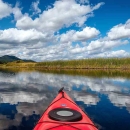States
DelawareEcosystem
Coastal, WetlandA $38 million marsh restoration at Prime Hook National Wildlife Refuge in Delaware, completed in 2016, repaired damage caused by Hurricane Sandy In 2012 and added storm and sea-level rise resilience into the natural landscape.
The restoration repaired breached marshes, restored dunes and rebuilt the damaged shoreline. About 4,000 acres of back-barrier tidal marsh were restored, which will enhance and support a long stretch of barrier beach along the Delaware Bay.
The effort involved carving out miles of marsh drainage channels, mostly following historic drainage patterns, then pumping in 1.1 million cubic yards of sand along 7,000 feet of shoreline to fill the deep cuts left by Hurricane Sandy and other storms. The dunes and restored beach area were planted with native beach grasses and shrubs to hold the sand in place.
The restored marshes have created additional habitat for birds, including American oystercatchers and federally listed species such as rufa red knots and piping plovers. The restoration also provides enhanced storm protection for nearby residents.
Federal funding through the Hurricane Sandy Disaster Relief Act made the project possible.
The project was the largest tidal marsh restoration project ever in the Eastern United States. The restoration is an example of a nature-based solution. Nature-based solutions are sustainable practices that use environmentally friendly features or processes to make landscapes more resilient.








